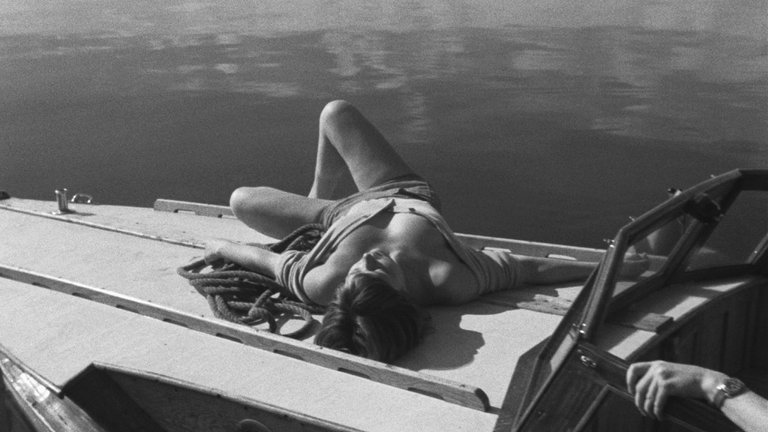Film Review: Summer with Monika (Sommaren med Monika, 1953)

Swedish director Ingmar Bergman has built his reputation of cinema giant on the series of profound art films. Yet, his filmography was, sometimes in roundabout ways, also connected to realm of exploitation cinema. One such example can be found in his 1953 drama Summer with Monika, which is considered to be one of Bergman’s most popular and most accessible films.
The film is based on the eponymous 1949 novel by Per Anders Fogelström. The plot begins in Stockholm when we are introduced to two working class youths – Harry (played by Lars Ekborg) and Monika (played by Harriet Andersson). Both of them work dead-end jobs and are unhappy with their lives – Harry lives with emotionally distant and sickly father, while Monika shares small apartment with numerous siblings and alcoholic father who beats her. Two of them begin passionate love relationship and after rebellious Monika quits her job and abandons her abusive dysfunctional family, some of that rebelliousness rubs on Harry. He gives her temporary accommodation in father’s boat and later quits his job. The pair decides to spend summer cruising around Stockholm Archipelago. Their idyll ends with summer, when the lack of food, money and Monika’s pregnancy forces them to return to civilisation. Harry and Monika marry and Harry gets job and enrols in night school in order to provide for their daughter. Monika is, however, increasingly unhappy with her domestic life and begins using husband’s work-related absences as opportunity for adulterous affairs.
Bergman, who also wrote the script, masterfully directs a narrative that evolves from romantic melodrama to a poignant portrayal of social realism. The film delves into the complexities of teenage love and the inevitable clash with the demands of maturity. Summer with Monika benefits a lot from good cast, especially from Harriet Andersson, young and relatively unknown actress who briefly became Bergman’s real life romantic partner and muse before becoming one of his most valuable collaborators. Andersson adds a lot of realism to the film with her image, which is both sexually attractive yet plain-looking, and, at the same time, radiates “wild side” and disdain for conventions of both the society and relationship with Harry.
The black-and-white cinematography by Gunnar Fischer accentuates the contrast between the serene beauty of the Stockholm Archipelago and the oppressive urban settings where Harry and Monika confront their future. The bleak urban landscape of Stockholm, with its towering buildings and entrapment, symbolizes the constraints and limitations faced by the characters. Monika's free-spirited and adventurous nature contrasts with Harry's easygoing demeanour, highlighting the complexities of their relationship within the context of their socio-economic background.
While the film excels in its realism, certain scenes like Harry's boat being vandalized by a stranger may seem slightly out of place, offering symbolic commentary on fate that feels somewhat forced. The detail that caught most attention for early 1950s audiences was a scene during which Harriet Anderson appears nude. Although rather timid for today’s standard, this scene – briefly repeated near the end as Harry’s memory – has, just like similar scene in One Summer of Happiness, created global perceptions of Swedish cinema and Sweden in general as sexually liberated compared with other countries. This perception, further underlined by bizarre 1955 US version Monika, the Bad Girl (re-edited with few extra scenes of nudity reshot), is rather obsolete now. Taken without the context of Sexual Revolution in cinema, Summer with Monika is best appreciated as simple, comprehensible and, most importantly, well-made piece of cinema.
RATING: 7/10 (+++)
Blog in Croatian https://draxblog.com
Blog in English https://draxreview.wordpress.com/
InLeo blog https://inleo.io/@drax.leo
Hiveonboard: https://hiveonboard.com?ref=drax
Rising Star game: https://www.risingstargame.com?referrer=drax
1Inch: https://1inch.exchange/#/r/0x83823d8CCB74F828148258BB4457642124b1328e
BTC donations: 1EWxiMiP6iiG9rger3NuUSd6HByaxQWafG
ETH donations: 0xB305F144323b99e6f8b1d66f5D7DE78B498C32A7
Posted using CineTV
This blog post provides an insightful analysis of Ingmar Bergman's film "Summer with Monika" and its exploration of love, rebellion, and social constraints. The post eloquently captures the nuances of the characters' struggles and the film's impact on cinema at that time. It's wonderful to see such detailed appreciation of Bergman's work and the performances of the actors, especially Harriet Andersson. The post's discussion of the film's visual contrasts and thematic depth adds to its overall appeal. It's clear that the author has a deep admiration for the artistry and storytelling in "Summer with Monika." Your enthusiasm for this classic piece of cinema shines through in your writing, and it's uplifting to see such dedication to highlighting the beauty and complexity of this film. Keep up the great work in sharing your love for cinema with your audience!